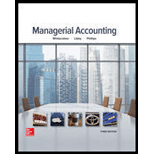
Calculating Target Profit, Margin of Safety, Degree of Operation Leverage
Refer to the information regarding Dana’s Ribbon World in E6-10.
1. Suppose Dana’s would like to generate a profit of $800. Determine how many rosettes must sell to achieve this target profit.
2. If Dana’s sells 1,100 rosettes, compute its margin of safety in units, in sales dollar, and as a percentage of sales.
3. Calculate Dana’s degree of operating leverage if sells 1,100 rosettes.
4. Using the degree of operating leverage, calculate the change in Dana’s profit if unit sales drop to 935 units. Confirm this by preparing a new contribution margin income statement.
(a)
Concept introduction:
Contribution Margin:
The margin of profit which is computed after considering the variable cost only and not the fixed costis known as contribution. In other words, it means the contribution made by selling the product after covering its variable cost to the company.
Target Profit:
The target profit is that profit which a company decides to achieve and this analysis helps in determinig the level of sales by which this target can be achieved.
The number of rosettes to be sold to achieve target profit of
Answer to Problem 11E
The target sale point in units is
Explanation of Solution
Contribution Margin Income Statement
| Particulars | Amount | |
| Sales Price |
||
| Variable Cost per Canoe |
||
| Contribution Margin |
The number units to be sold for achieving the target profit are calculated as:
(b)
Concept introduction:
Breakeven Point:
The level of sales where the company is neither on profit nor loss is termed as breakeven point. In other words, that level of sales at which the fixed cost of the business is recovered.
Margin of Safety:
The margin of safety is the margin enjoyed by the company which is achieved over and above the breakeven sales. It is a difference of actual sales and breakeven sales.
To compute:
The margin safety in units and percentage of sales if the sales price is
Answer to Problem 11E
The margin safety in units and percentage of sales is
Explanation of Solution
The actual sales amount to
The breakeven sales amount to
The margin of safety in terms of units is calculated as:
The margin of safety in terms of percentage of sales is calculated as:
(c)
Concept introduction:
Degree of operating leverage:
The degree of oprating leverage refers to the level of fixed cost incurred for operating the business, and the higher leverage means there is a high fixed cost. It is computed by dividing the contribution margin with net operating income.
The degree of operating leverage at the levelof sale of
Answer to Problem 11E
The degree of operating leverage is
Explanation of Solution
Contribution Margin Income Statement
| Particulars | Amount | |
| Sales Price |
||
| Variable Cost per Canoe |
||
| Contribution Margin |
Thetotal contribution margin and net operating income are calculated as:
The degree of operating leverage is calculated as:
(d)
Concept introduction:
Degree of operating leverage:
The degree of oprating leverage refers to the level of fixed cost incurred for operating the business, and the higher leverage means there ia a high fixed cost. It is computed by dividing the contribution margin with net operating income.
The change in profit on the basis of degree of operating leverage if the sales price is reduced to
Answer to Problem 11E
The change in profit on the basis of degree of operating leverage, if the sales price is reduced to
Explanation of Solution
The percentage of sales decrease is:
Operating Leverage is
Change in Profit is calculated as:
This means when the sale will decrease, it will lead to reduction in the profit by
Contribution Margin Income Statement
| Particulars | Amount | |
| Sales Price |
||
| Variable Cost per Canoe |
||
| Contribution Margin |
||
| No. of units | ||
| Contribution margin | ||
| Less: Fixed cost | ||
| Net Income |
Want to see more full solutions like this?
Chapter 6 Solutions
Managerial Accounting
- Bon Corporation has the following transactions: $820,000 operating income; $640,000 operating expenses; $55,000 municipal bond interest; $150,000 long-term capital gain; and $70,000 short-term capital loss. Compute Bon Corporation's taxable income for the year.arrow_forwardI need help with this financial accounting question using standard accounting techniques.arrow_forward4 PTSarrow_forward
- Can you help me solve this general accounting problem using the correct accounting process?arrow_forwardI need help with this general accounting question using standard accounting techniques.arrow_forwardCan you demonstrate the proper approach for solving this financial accounting question with valid techniques?arrow_forward

 AccountingAccountingISBN:9781337272094Author:WARREN, Carl S., Reeve, James M., Duchac, Jonathan E.Publisher:Cengage Learning,
AccountingAccountingISBN:9781337272094Author:WARREN, Carl S., Reeve, James M., Duchac, Jonathan E.Publisher:Cengage Learning, Accounting Information SystemsAccountingISBN:9781337619202Author:Hall, James A.Publisher:Cengage Learning,
Accounting Information SystemsAccountingISBN:9781337619202Author:Hall, James A.Publisher:Cengage Learning, Horngren's Cost Accounting: A Managerial Emphasis...AccountingISBN:9780134475585Author:Srikant M. Datar, Madhav V. RajanPublisher:PEARSON
Horngren's Cost Accounting: A Managerial Emphasis...AccountingISBN:9780134475585Author:Srikant M. Datar, Madhav V. RajanPublisher:PEARSON Intermediate AccountingAccountingISBN:9781259722660Author:J. David Spiceland, Mark W. Nelson, Wayne M ThomasPublisher:McGraw-Hill Education
Intermediate AccountingAccountingISBN:9781259722660Author:J. David Spiceland, Mark W. Nelson, Wayne M ThomasPublisher:McGraw-Hill Education Financial and Managerial AccountingAccountingISBN:9781259726705Author:John J Wild, Ken W. Shaw, Barbara Chiappetta Fundamental Accounting PrinciplesPublisher:McGraw-Hill Education
Financial and Managerial AccountingAccountingISBN:9781259726705Author:John J Wild, Ken W. Shaw, Barbara Chiappetta Fundamental Accounting PrinciplesPublisher:McGraw-Hill Education





